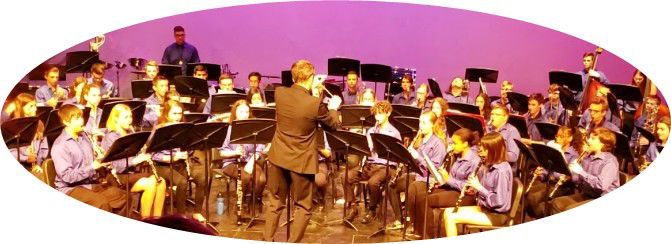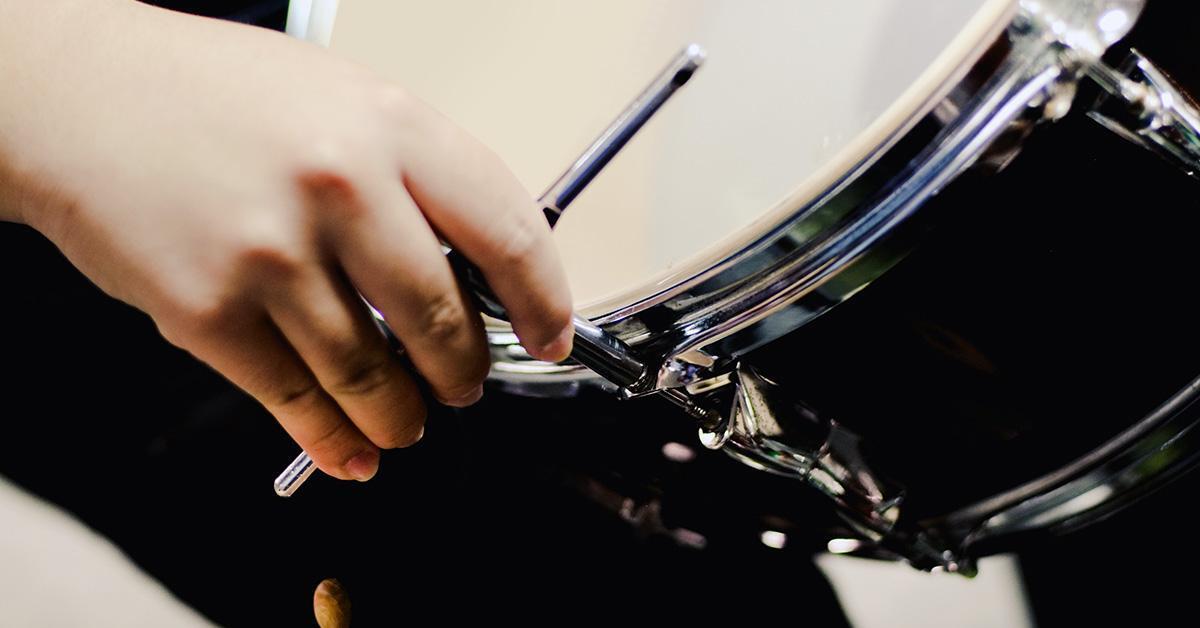How a Concert Band Can Stay in Tune

A concert band has a number of challenges, any of which could derail an otherwise excellent ensemble. Among those challenges is the ability for the band to stay in tune. Even if every musician plays their notes with the proper fingering, attack, duration, and articulation, poor intonation can make the music sound messy or unpleasant. A well-tuned band, however, creates a beautiful, blended sound that is pleasing to the ear. Here are some key steps concert bands can take to stay in tune.

1. Start with Proper Instrument Tuning
Each player must make sure their instrument is in tune before the rehearsal or performance begins. This usually means tuning to a standard pitch, such as A=440 Hz.
Why do most ensembles tune to A-440 Hz? Before a standard frequency was used, some groups tuned as low as A370. These were mostly Baroque instrumental groups, which wanted a warmer sound. In other places, particularly in areas where opera was popular, orchestras were tuned as high as A470. Most singers complained about this because it strained their voices, especially if the piece had been written by someone using a much lower frequency for A.
Even from area to area, and among different ensembles during the same time period, tuning was inconsistent. For most of history, instruments were hand made and tuned to whatever frequency the instrument maker desired. If there was to be an ensemble, the instruments maker(s) would be sure that that particular ensemble was in tune with the other instruments in it. As time went on, instrument makers in a particular area would coordinate their tuning frequency to enable musicians to play with a wider assortment of other musicians, but there was still no generally agreed-on tuning frequency.
In 1936, when instruments were beginning to be more mass-produced, musicians and instrument makers in the United States agreed on A-440 Hz as the standard. Britain adopted the same frequency in 1939 and, finally, in 1955, the ISO (International Organization for Standardization) codified the A-440Hz standard because of the need for industrial and international standardization.
Currently, there is a fad that instruments should be tuned to A-444, supposedly because it’s a more spiritually in tune and God-friendly frequency. It’s very common among guitar players, who have no trouble changing their instrument’s tuning. However, this make it possible for virtually no other instrument to be able to play with them.
Most bands tune to a concert B-flat played by an instrument with stable pitch, like an electronic tuner or a piano. If that isn’t available, a brass instrument like a trumpet can be used for establishing a desired pitch since brass instruments are the least likely to go out of tune if the air temperature is relatively normal.
Once they hear the standard pitch, brass players should adjust their tuning slides and woodwind players should adjust their mouthpieces, including reed placement. Since temperature and humidity can affect tuning, it's important to recheck throughout the rehearsal or performance.

2. Develop Good Listening Skills
Musicians must actively listen to those around them. Instead of only focusing only on their own playing, they should match their pitch to others, especially to the instruments that carry the melody or the bass line. Section leaders and directors can encourage musicians to blend their sound and adjust when they hear something out of tune.
It’s extremely rare that a whole ensemble would go out of tune, so, when musicians are listening to be sure that they are in proper tune, they can adjust to the tuning of those nearest to them.
3. Use a Tuner Regularly
Personal tuners can help musicians develop a habit of playing in tune. Before playing, musicians should check their tuning, and they can also use tuners during practice to see if their notes are consistently sharp or flat.
However, relying too much on a tuner can weaken the ear’s ability to adjust naturally. One can develop the skill of relative pitch, that is, the ability to hear if a note or melody is being played with the same pitches as when it started. It takes some effort and practice, but it is still quite achievable. INSERT WARM-UP 1 HERE IN BAND

4. Warm Up Properly
Instruments tend to be sharper when cold and flatter when warmed up. The ambient temperature must also be considered. Even though concert bands generally play inside, that doesn’t always mean that the furnace or air conditioner is working well. A good warm-up routine is essential for tuning stability. A solid warm-up helps players establish a norm for theirs horns before tuning and playing together. Warm-ups should include long tones, scales, and a small assortment of other exercises, both as individual players and a group, to ensure proper blending and tuning.
5. Understand Pitch Tendencies of Instruments
Each instrument has certain notes that naturally tend to be slightly sharp or flat. Musicians should be aware of which of these tendencies occur in their particular horn and compensate by adjusting their embouchure, finger position, or air support.
Even if the Bb used by the horn player to tune is in perfect tune, it may ensure that most of the other notes are also in tune. However, there are always a note or two that, usually, by the nature of the horn, are out of tune. These often occur in the higher or lower registers of the instrument or, in the case of woodwinds, when a complicated fingering is required.
The temptation by players of valved brass instrument players may be to adjust the valve slides to compensate for an out of tune low note, but this will affect all of the other mid-range notes as well. The only thing that can be done for a sharp low note is to “lip it down”, that is, relax the embouchure to compensate. If the passage is such that the note isn’t played for any discernable length of time (perhaps an eighth note) adjustment is unnecessary since the listener wouldn’t be able to hear anything objectionable.

6. Balance and Blend
A well-balanced band has a better chance of staying in tune. If one section overpowers another, it can throw off the overall sound. The band should aim for a pyramid of sound, with lower instruments providing a strong foundation and higher instruments playing with a lighter touch, depending of course, on the dynamics required by the music.
All of the instruments don’t play all of the time, so there are breaks when some of the instruments can be heard more clearly. With a good ear, musicians can tell if their instruments are in tune with instruments that they can’t normally hear while they are playing.
7. Use Tuning Exercises
Directors can lead exercises that help musicians improve their intonation, such as:
- Drone tuning – Playing against a drone note to train the ear to hear and adjust pitch. This will also help with training ears to develop relative pitch.
The director should also introduce the ensemble to the concept of “beats” when listening to two or more instruments playing together. The simple explanation is this – when two notes are played at exactly the same frequency, the waves overlap and match perfectly. That’s why the music sounds louder when two or more play that way. If the frequencies of the waves are just a bit different, the parts of the wave that are stronger create what is called a “beat”, which sounds more like a “wah-wah” sound. The farther apart the frequencies of each instrument are, the slower the beats are; and the closer together the frequencies, the faster the beats. The easiest way to hear this might be to have two trombones play the same note with their slides at slightly different positions.
- Tuning in sections – Sectional tuning helps smaller groups match their sound before tuning as a full band. The lead player in the section should tune to the fixed pitch (pitch pipe, keyboard, etc.). Then, the section can tune to the lead instrument. That way, the players in that section can more easily hear which, if any instruments are out of tune, most likely by hearing the beats.
- Interval exercises – Practicing octaves, fifths, and thirds can help players adjust to natural harmonic relationships. It might be interesting for the director to introduce the group to, or remind them about, the overtone series. This scientific phenomenon is the ground-work for all of our musical tones and chords. For a better understanding of the overtone series, see the article entitled How the Overtone Series Affects Music Composing and Arranging .
8. Encourage Good Air Support and Technique Poor breath control can cause inconsistent pitch, especially in woodwind and brass players. Musicians should focus on steady, controlled airflow to maintain a stable tone. Proper posture and breath support can help prevent unintentional pitch changes.

Proper Posture – The first thing that wind players need to do when developing good breathing practices is to have great posture. Whether sitting or standing, wind musicians should do the following to establish great posture:
- When sitting, sit so that the back does not touch the back of the chair. Feet should be flat on the floor, shoulders relaxed, and head perched directly on top of the spinal column.
- When standing, stand with the feet about as wide as the shoulders. The legs should be straight but the knees should never be locked. Locked knees restrict blood flow and can result in dizziness or fainting.
- To create the largest amount of room for breathing, wind players can imagine a string attached to the very top of the head, like a marionette, and that the string is pulling the head straight upward, creating the greatest distance between the sternum and the belly button.
Proper Breathing – When breathing properly, a wind player’s instrument has more power, more control, and a fuller, more expressive tone, even when not playing loudly. For the breathing itself, the simple thing to say, and the tricky thing to do, is to Breathe from the Diaphragm.
In reality, all breathing is accomplished by the diaphragm. However, the term “Breath from the Diaphragm” refers to the practice of pushing the belly out to make room for the air instead of trying to expand the chest or even raising the shoulders.
It is critically important to use proper breathing techniques to be able to play with a good tone, for a long time. In order to breathe properly, a wind musician’s body should be at its best posture. Then, before even starting instrumental warm-ups, a musician can use these exercises to improve their breathing techniques.
Here’s a great Diaphragm Muscle Builder. This one is probably better done in the privacy of one’s home. It’s best for developing the diaphragm muscle itself. The wind player would lie on the floor on the back. Form a small opening in the mouth, about as big as the tip of a pinky finger. Inhale only through this small opening in the mouth and consciously push the stomach out to make room for the air to enter the lungs; shoulders and chest should not move. When the lungs are full, exhale through the mouth while maintaining the stomach’s pushed-out position. This acts as a sort of isometric exercise for the diaphragm muscle.
9. Adjust on the Fly
Even if the band starts in tune, changes in dynamics, fatigue, or temperature can cause tuning issues. Musicians should develop the skill of adjusting their pitch while playing by using their ears, embouchure, or instrument adjustments.
The first thing that any player should do if it is suspected that the horn is out of tune in some way, is to determine the cause.
- If it’s a large change in dynamics, the embouchure needs to be tightened or relaxed, depending on in which direction the horn is out of tune.
- If fatigue is the cause, the player could try to do some mouth stretches, loose lip buzzes (these are especially good for brass players), shoulder hunches to release tension, or other ways that would refresh the musician.
10. Develop a sense of Awareness About Intonation
A great band prioritizes intonation. Directors should encourage musicians to take responsibility for their own tuning and listen carefully to others. When every musician is committed to playing in tune, the entire band benefits.

11. Don’t forget the percussion
It may sound odd, but the drums in a concert band need to be tuned properly. In a concert band, they are tuned a bit differently than in a marching band or drum line. This is because they don’t need to project nearly as far, and they also need to blend better with the instruments, sometimes playing a wider dynamic range.
- The Snare Drum should have enough punch to perform its job of providing the proper snare effect in the music without being too snappy or shrill. In a perfect world, all the snare drums in a concert band are also tuned to each other.
- The Tenor Drum, in the same way, should have a bit warmer sound in concert band than when it is used in a marching band, able to do its job without being overbearing.
- The Bass Drum needs enough kick to provide a precise beat, while at the same time, having a nice “boom” to it to provide a sense of blending with the rest of the band.
- Cymbals are, by their very nature, loud. The only way to have a cymbal that is in tune is to find one that is the right tone, color and volume to fit the needs of the band. A small band requires smaller cymbals, whether crash or ride, that won’t overpower the instruments, and won’t drive the cymbal player crazy trying to control oversized cymbals.
- It goes without saying that the Timpani need to be in tune as perfectly as possible, especially since they were designed a s tuned percussion.
Conclusion
Staying in tune requires effort from every musician in a concert band. By focusing on proper tuning, listening, warming up, and blending, a band can create a beautiful and harmonious sound. With practice and discipline, tuning issues can be minimized, allowing the music to shine.
Salt Cellar Creations understands the beauty and power that a Concert Band can convey and the challenge that band directors face in choosing the best music for their ensemble. SCC has a growing library of original works and arrangements to help meet the needs of band teachers and directors. Find out more about what Salt Cellar Creations has to offer for Concert Bands HERE. Explore the available music HERE.
SCC can also compose an original piece for you or do a custom arrangement for you to allow you to showcase your group. There are two ways that this can be done; one is much more affordable than the other. CONTACT US for more information. And SCC is always looking for ideas of pieces to arrange or suggestions for original pieces.
We have written and arranged music for groups not only in the US but also in Canada, the United Kingdom, France, Australia, New Zealand, and Austria. Please CONTACT US to let us know what we can do for you!